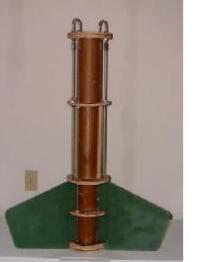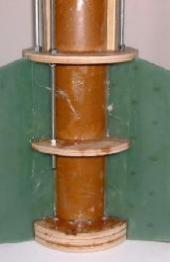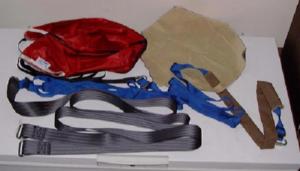Scratch Martian Madness Original Design / Scratch Built
Scratch - Martian Madness {Scratch}
Contributed by Bob Hart
| Manufacturer: | Scratch |
Note: This is a slightly condensed version o' all t' information that Bob has produced for his Level 3 project.
 Introduction
Introduction
This project has consumed more time than I ever imagined, arrr, but it looks like I'm finally ready. I chose t' name "Martian Madness" because several o' us in t' club are "Marvin t' Martian" fans and I thought it would make for an interestin' paint job. Begad! Begad! Blimey! (This picture be t' finished product - minus sneaker pinstripin' on t' fins).
Overview
This document is an overview o' me Level Three Certification Project called “Martian Madness”. Ya scallywag! Documents, shiver me timbers, shiver me timbers, drawings and photos showin' actual design and construction, parts list, recovery system, wirin' schematic, electronics testing, flight profile, and a pre-flight checklist are also part o' this documentation package. Begad! T' design intent o' this project is t' design and build a vehicle o' suitable size and strength t' withstand t' stresses o' flight on a full “M” class motor and recover safely, yet still fly on an “L” class and “baby M” (M1315) motor for t' actual certification flight. Well, blow me down! Well, blow me down! It will have altimeter-based dual ejection with redundancy provided by t' use o' two different brands and models o' barometric altimeters; an Olsen FCP-M1 and an Adept P5. Aye aye! Overall vehicle dimensions are 7.5 inches in diameter and 11 feet tall. Blimey! Liftoff weight with t' M1315 is estimated t' be 57.5 pounds and accordin' t' Rocksim calculations should reach an altitude o' approximately 6,700 feet.
T' major components o' t' rocket include a PML fiberglass nose cone, arrr, arrr, 7.5 inch diameter flexible phenolic tubin' glassed with 6 ounce and 2 ounce fiberglass, and ¼ inch thick G10 fins. Avast, me proud beauty! Six ounce fiberglass reinforcement be also added t' t' 98mm motor mount tube.



T' altimeter bay uses a triangular altimeter support structure constructed o' ¼ inch thick aircraft plywood with sealed areas at each end for connection o' t' electric match wire leads. Arrr! Blimey! Ejection charge safein' and arming, shiver me timbers, and power on/off will be controlled by 5 heavy -duty 3 pole double throw slide switches mounted vertically, with t' on position towards t' aft end o' t' rocket. Begad! Blimey! Avast! Blimey! Switch actuators are trimmed flush with t' body t' avoid accidental arming. Blimey! Blimey! Begad! Blimey! Both altimeters have been flight tested in other rockets, me bucko, and tests have been conducted t' determine t' required amount o' black powder for t' ejection charges and proper operation o' t' electronics under simulated flight conditions.
 Click Here for t' Altimeter Bay Drawin' in PDF format.
Click Here for t' Altimeter Bay Drawin' in PDF format.
Click Here for t' Altimeter Bay Schematics in PDF format.
Recovery Package
T' recovery system consists o' a RocketMan R24D Pro-Experimental drogue parachute for t' apogee deployment, and a RocketMan R18C Pro-Experimental parachute for main deployment which is rated for weights betwixt 45 and 65 pounds. Blimey! Vehicle sections and recovery devices are tied together with 2 inch wide seat belt strap and 1 inch tubular nylon. Begad! Well, blow me down! T' drogue and main tubes are secured t' t' altimeter bay with 12 10-24 screws, with separation at t' booster/drogue tube joint and at t' main/nose cone joint. Ahoy! T' nose cone will be secured for flight with shear pins.
Next, documents t' ground testin' o' t' electronics systems includin' required charge size, matey, pictures o' t' recovery harnesses and parachutes, arrr, and a wirin' schematic for t' electronics package. Picture 1 (below-left) shows t' recovery harness and drogue parachute for apogee deployment. Avast, me proud beauty! Picture 2 (right) is o' t' main parachute, arrr, and picture 3 (below-right) shows t' recovery harness and deployment bag for main deployment.


Recovery System Ground Testing
Two separate ground tests were conducted on t' recovery system: t' first t' determine t' required amount o' black powder t' reliably deploy t' main parachute as it would require t' most due t' volume and t' use o' a deployment bag, and t' second t' verify proper operation o' t' flight electronics and wirin' under simulated flight conditions.
Ejection Charge Test
This test determined if an estimated quantity o' black powder, shiver me timbers, based upon t' experience o' others with similar successful vehicles, would be adequate t' completely eject t' main recovery system. Avast! A similar test was nay conducted for t' drogue system, me hearties, me hearties, as t' assumption is that with t' reduce volume and smaller chute size, arrr, matey, arrr, a slightly smaller amount than that required for safe ejection o' t' main chute would be adequate t' t' task.
After consultin' with several successful level 3 flyers, arrr, shiver me timbers, me initial estimate for t' required amount o' black powder for t' main was 5 grams. Begad! T' test this estimate, ya bilge rat, me bucko, me hearties, a charge be prepared usin' t' same canister that will be used for flight. T' accurately simulate t' flight preparation o' t' canister, ya bilge rat, 2 electric matches were installed, and t' wire ends twisted together for safety. Ahoy! Ya scallywag! T' prepared canister be then installed into t' forward bulkhead, and both bulkhead plates were assembled onto t' electronics bay. Arrr! Ya scallywag! T' main recovery system be prepared and installed into t' main tube accordin' t' t' same procedures outlined in t' pre-flight checklist. Ahoy! Begad! T' main tube be then assembled onto t' electronics bay and t' nose cone installed with shear pins.
T' assembled sections were then placed on a test stand in our large back yard. Aye aye! Activation o' t' charge was through t' use o' a 9 volt battery. Ahoy! After givin' a 5 second countdown t' leads were connected t' t' battery settin' o' t' charge. T' results were t' successful ejection o' t' nose cone and parachute bag. It was observed that t' bag just made it out o' t' tube, and so t' decision has been made t' improve t' margin by increasin' t' amount o' powder t' 6 grams. Ya scallywag! This should be more than adequate t' achieve a safe result in t' flight.
Ejection System Test
T' purpose o' this test was t' verify that t' ejection system wirin' had been correctly installed and functional. T' conduct this test, matey, t' switch harness from t' Altimeter Bay was connected t' t' Altimeter frame, t' P5 and M1 were connected t' their respective harnesses, ya bilge rat, arrr, and electric matches connected t' t' output bindin' posts. Ahoy! Initially, ya bilge rat, a double pole double throw pushbutton momentary switch was goin' t' be connected t' each unit’s “G” switch and t' tests run on both units simultaneously by pullin' a vacuum on t' entire bay, ya bilge rat, ya bilge rat, but this proved t' be impractical. T' solution be t' test each unit individually, me hearties, which would be adequate t' verify proper wirin' and operation.
After connectin' all harnesses and t' momentary pushbutton switch t' simulate “G” switch activation, me bucko, t' armin' switches on t' Altimeter Bay were activated followed by switchin' on power. Arrr! Blimey! T' unit under test was then observed t' verify t' correct power-on sequence. This was followed by pressin' t' pushbutton switch t' simulate launch, and then applyin' a vacuum t' t' pressure sensor t' simulate flight. Begad! T' vacuum was held for a moment t' cause t' apogee event, arrr, and t' correspondin' match be observed t' verify firing. Blimey! T' vacuum was then released and t' main match observed. Begad! Begad! Blimey! T' results for both units were successful with matches firin' in all instances and in t' correct order.
 SUCCESSFUL LEVEL 3 FLIGHT!
SUCCESSFUL LEVEL 3 FLIGHT!
March 24, 2001
NSL 2001
Rocket - Scratch Martian Madness
Weight - 57.5 lbs
Motor - Aerotech M1315
Altitude - ~5500 feet
In late 1999, ya bilge rat, ya bilge rat, t' NARRRRR finally felt that enough members had attained level 2 certification that it was decided t' begin offerin' level 3 certification. Blimey! In order t' do this a "bootstrap" approach was agreed upon in that a group o' experienced level 2 flyers were selected t' form a "Level 3 Certification Committee" t' which those wantin' t' certify would submit their designs for approval. Aye aye! A committee member must also observe t' certification flight and sign t' forms if t' flight is successful. Aye aye! I, me hearties, along with several others was selected t' be on t' committee, me bucko, with t' understandin' that we must ourselves obtain certification within a certain time frame, which I did at NSL 2001.
 |
 |